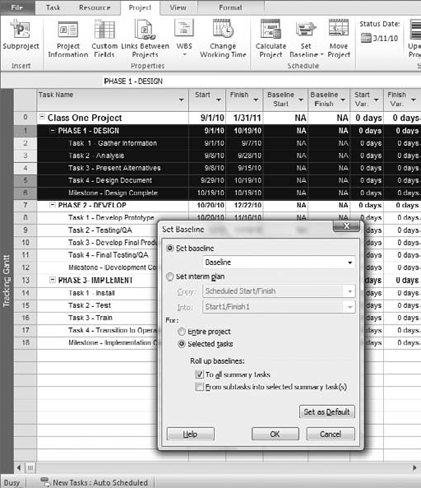2. Rolling-Wave Planning with Baselines
If you're following a rolling-wave planning
approach, you can use the baseline function and take advantage of the
Set Baseline for Selected Tasks option. For example, if you have a
stage-gate process, which includes planning the detail for the next
gate prior to moving on, then this approach will work for you.
Perhaps you know the detail of only one phase and
aren't ready to set the baseline for the next until it becomes clearer.
For example, until the requirements are defined, you won't have the
final details of how long the design stage will take; and until the
design is completed, you may not have a clear understanding of how long
development will take. In these types of situations, you can apply a
rolling-wave planning approach and progressively elaborate on the
details as you move from one phase to the next.
You can set the baseline for a specific phase or series of tasks as follows (see Figure 3):
Select the tasks in the Gantt chart for which you want to set the baseline.
Select Project tab => Schedule group => Set Baseline drop-down list => Set Baseline.
In the Set Baseline box, make sure the Set Baseline option is selected.
Under For, select Selected Tasks.
Under Roll Up Baselines, select To All Summary Tasks. Click OK.
The option to roll up baselines to summary tasks is
important if you want the summary-task baseline to change and reflect
the impact of the baseline of the tasks. You also have a choice to
manually select the summary tasks first and choose the second option,
which rolls up baselines from subtask to selected summary tasks only.
This option may be useful if you want to affect only one summary task
without affecting others, such as the project summary.

3. Adding New Tasks After a Baseline Has Been Set
Many times, after the baseline has been set and the
project has started, you may need to add new tasks to your project
plan. Perhaps you want to add details for more accurate tracking, or a
change in scope results in the need for more tasks. When you add new
tasks, you need to set the baseline for those tasks without resetting
the baseline for the entire project.
As shown in Figure 4,
when you add a new task, no baseline is associated with it until you
follow the same steps as described in the previous section for Figure 3.
